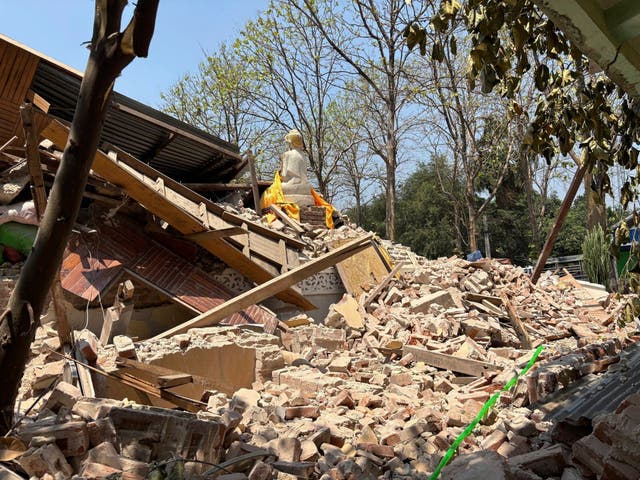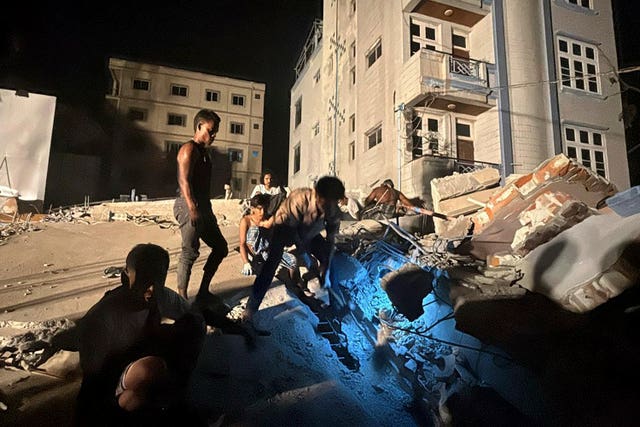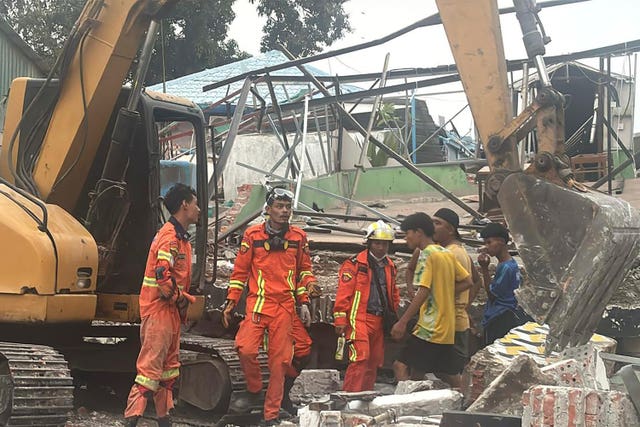Myanmar hit by 5.1-magnitude aftershock following Friday’s earthquake
Emergency rescue teams have started trickling into the area of the country hardest hit by Friday’s massive quake.

A 5.1-magnitude earthquake hit near Myanmar’s second-largest city on Sunday, the latest in a string of aftershocks following Friday’s natural disaster.
People in the streets of Mandalay screamed as the aftershock – which was recorded by the United States Geological Survey – hit.
Emergency rescue teams have started trickling into the area of the country hardest hit by Friday’s massive quake that killed more than 1,600 people.
Their efforts have been hindered by buckled roads, downed bridges, poor communications and the challenges of operating in a country in the midst of a civil war.
The 7.7-magnitude quake hit at midday on Friday with an epicentre near Mandalay, Myanmar’s second-largest city, bringing down scores of buildings and damaging other infrastructure like the city’s airport.
Many of Mandalay’s 1.5 million people spent the night sleeping on the streets, either left homeless by the quake, which also shook neighbouring Thailand and killed at least 18 people there, or worried that the continuing aftershocks might cause structures left unstable to collapse.

So far, 1,644 people have been reported killed in Myanmar and 3,408 injured, but many areas have not yet been reached, and many rescue efforts so far have been undertaken by people working by hand to try and clear rubble, said Cara Bragg, the Yangon-based manager of Catholic Relief Services in Myanmar.
“It’s mainly been local volunteers, local people who are just trying to find their loved ones,” Ms Bragg said after being briefed by her colleague in Mandalay.
The organisation was sending a team by road on Sunday to assess the most pressing needs so that it could target its own response.
With the Mandalay airport damaged and the control tower toppled in the capital Yangon’s Naypitaw airport, all commercial flights into the cities have been shut down.
Still, two Indian C-17 military transport aircraft were able to land late on Saturday at Naypitaw with a field hospital unit and some 120 personnel who were then to travel north to Mandalay to establish a 60-bed emergency treatment centre, according to the country’s foreign ministry.
Other Indian supplies were flown into Yangon, Myanmar’s biggest city, which has been the hub of other foreign relief efforts.

On Sunday, a convoy of 17 Chinese cargo trucks carrying critical shelter and medical supplies was expected to reach Mandalay after making the arduous 400-mile journey by road from Yangon.
An initial report on earthquake relief efforts issued on Saturday by the UN Office for the Co-ordination of Humanitarian Affairs noted the severe damage or destruction of many health facilities, and warned a “severe shortage of medical supplies is hampering response efforts, including trauma kits, blood bags, anaesthetics, assistive devices, essential medicines, and tents for health workers”.
China said it has sent more than 135 rescue personnel and experts along with supplies like medical kits and generators, and pledged around 13.8 million US dollars (£10.65 million) in emergency aid.
Russia’s emergencies ministry said it had flown in 120 rescuers and supplies to Yangon, and the country’s health ministry said Moscow had sent a medical team to Myanmar.
Rescue efforts are complicated by the bloody civil war roiling much of the country, including in quake-affected areas.
In 2021, the military seized power from the elected government of Aung San Suu Kyi, sparking what has since turned into significant armed resistance.

Government forces have lost control of much of Myanmar and many places are dangerous or impossible for aid groups to reach.
More than three million people have been displaced by the fighting and nearly 20 million are in need, according to the United Nations.
The government military has been fighting long-established militias and newly-formed pro-democracy People’s Defence Forces (PDF), and has heavily restricted much-needed aid efforts to the large population already displaced by war even before the earthquake.
On Saturday, Myanmar’s opposition shadow National Unity Government, to which the PDF militias are loyal, announced a unilateral partial ceasefire to facilitate earthquake relief efforts.
The military did not immediately comment on the announcement and it continued air strikes even after the earthquake.
The Three Brotherhood Alliance, a group of three of Myanmar’s most powerful and well-armed militias that launched a combined offensive in October 2023 that broke a strategic stalemate with the military regime, did not mention a ceasefire in a statement Saturday, but said it was ready to help.





